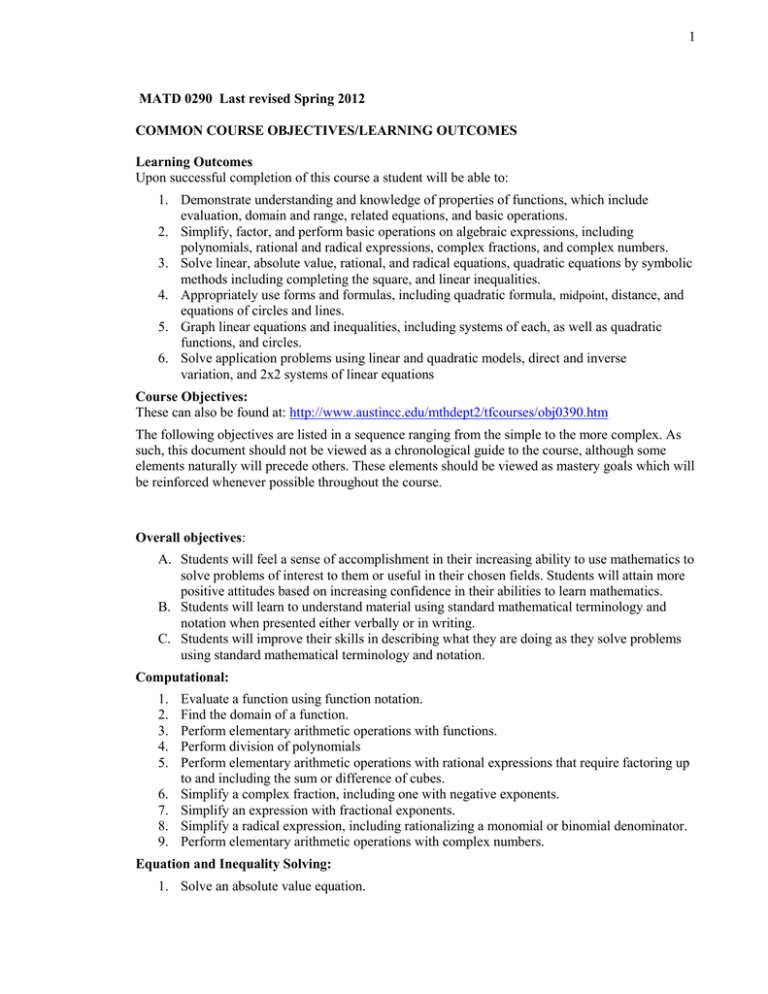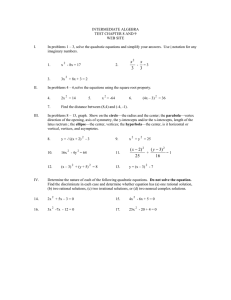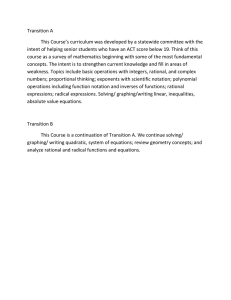1 MATD 0290 Last revised Spring 2012
advertisement

1 MATD 0290 Last revised Spring 2012 COMMON COURSE OBJECTIVES/LEARNING OUTCOMES Learning Outcomes Upon successful completion of this course a student will be able to: 1. Demonstrate understanding and knowledge of properties of functions, which include evaluation, domain and range, related equations, and basic operations. 2. Simplify, factor, and perform basic operations on algebraic expressions, including polynomials, rational and radical expressions, complex fractions, and complex numbers. 3. Solve linear, absolute value, rational, and radical equations, quadratic equations by symbolic methods including completing the square, and linear inequalities. 4. Appropriately use forms and formulas, including quadratic formula, midpoint, distance, and equations of circles and lines. 5. Graph linear equations and inequalities, including systems of each, as well as quadratic functions, and circles. 6. Solve application problems using linear and quadratic models, direct and inverse variation, and 2x2 systems of linear equations Course Objectives: These can also be found at: http://www.austincc.edu/mthdept2/tfcourses/obj0390.htm The following objectives are listed in a sequence ranging from the simple to the more complex. As such, this document should not be viewed as a chronological guide to the course, although some elements naturally will precede others. These elements should be viewed as mastery goals which will be reinforced whenever possible throughout the course. Overall objectives: A. Students will feel a sense of accomplishment in their increasing ability to use mathematics to solve problems of interest to them or useful in their chosen fields. Students will attain more positive attitudes based on increasing confidence in their abilities to learn mathematics. B. Students will learn to understand material using standard mathematical terminology and notation when presented either verbally or in writing. C. Students will improve their skills in describing what they are doing as they solve problems using standard mathematical terminology and notation. Computational: 1. 2. 3. 4. 5. 6. 7. 8. 9. Evaluate a function using function notation. Find the domain of a function. Perform elementary arithmetic operations with functions. Perform division of polynomials Perform elementary arithmetic operations with rational expressions that require factoring up to and including the sum or difference of cubes. Simplify a complex fraction, including one with negative exponents. Simplify an expression with fractional exponents. Simplify a radical expression, including rationalizing a monomial or binomial denominator. Perform elementary arithmetic operations with complex numbers. Equation and Inequality Solving: 1. Solve an absolute value equation. 2 2. Solve a rational equation, including one with a quadratic expression in the denominator. 3. Solve an equation with one radical. 4. Recognize an extraneous root. Using Forms and Formulas 1. Graph a function, such as a simple absolute value or rational function, by completing a table and plotting points. 2. Solve a quadratic equation with real or non-real solutions. 3. Find the midpoint and the distance between two points. 4. Complete a square to rewrite an equation for a circle in standard form and identify its center and radius. 5. Determine if a formula, correspondence, table or graph represents a function. Graphing: 1. Graph a linear inequality on the Cartesian plane. 2. Graph a system of linear inequalities on the Cartesian plane. 3. Graph and analyze a linear and quadratic function. () ( ) 2 4. Sketch a quadratic function, written in the form f x = a x - h + k , using transformations. 5. Sketch a circle from its standard form. Applications: 1. Represent English descriptions of numerical relationships in algebraic form. 2. Solve application problems including, but not limited to, linear and quadratic models, direct and inverse variation, and those requiring 2x2 systems of linear equations


